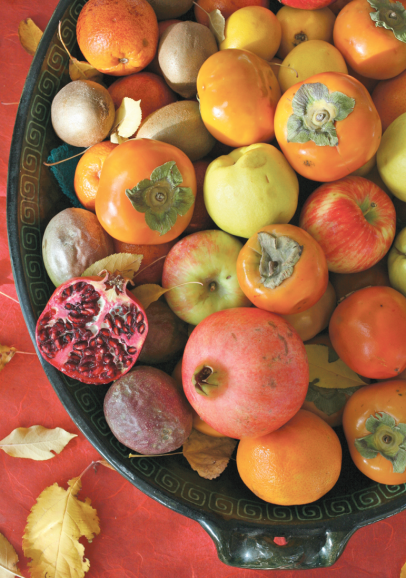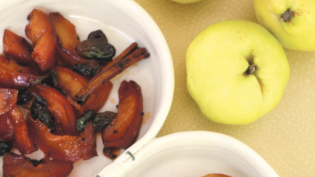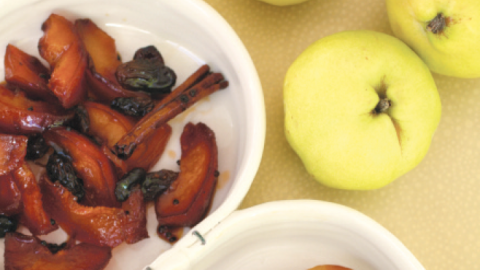The Exceptional Bounty of Fall Fruit
Ed note: Madison visited Phoenix in May for a celebration of the local peach harvest hosted by Slow Food Phoenix. We thoroughly enjoyed her visit and thought you’d appreciate her take on fall desserts.
I love making desserts and I like eating them, too. I’ve worked as a pastry chef on several occasions and have always included plenty of desserts in my books, so it was largely a matter of time before writing a book devoted to nothing other than the last course of the meal.
My book Seasonal Fruit Desserts from Orchard, Farm and Market started out with the working title, Desserts for the Pastry Impaired, partly because I consider myself to be somewhat pastry impaired. When I see a picture of a chocolate cake in the shape of a pyramid, its ganache coating mirror-smooth and perfect little rosettes all lined up in a row, I know profoundly that this is not something I want to undertake. Desserts that require enormous patience and skill are just not in the cards for me. Instead, I prefer to approach desserts in a more relaxed fashion, that is, as a cook. I like desserts you can roast and sauté, season and taste, and this approach led naturally to a focus on fruit along with a few easily managed doughs, creams and fruit-based sauces to transform fruit into full-fledged desserts that don’t require hours of solitary concentration.
I view fruits pretty much as I do vegetables: Both are produce and, in my kitchen, both are seasonally based. But more than vegetables, fruits (citrus being somewhat of an exception) must be seriously wedded to place if they’re to have flavor and perfume. Fruits don’t travel nearly as well as vegetables do, and while our freewheeling ways with shipping coast to coast have at last been seriously questioned, it’s far easier to get your hands on a good parsnip than it is to find a good plum. Fruit has suffered poorly at the hands of industrial agriculture and our habit of having everything all the time doesn’t help us see the world of fruit close up; that is, the fruits that thrive where we live.
Because season and place overlap, we in fact have hundreds and hundreds of little seasons in our large country, not just the big four. While my California friends might be enjoying apricots in May, in Santa Fe, at 7,000 feet, we won’t be seeing them until July. Rhubarb may be the first “fruit” (it’s actually a vegetable) to appear, but what a national magazine won’t say is that it persists in many places throughout the summer and can be paired just as nicely with blackberries as with the early strawberries. Peaches are finished in Phoenix by the end ofMay but not getting started until August elsewhere, and so it goes.
But despite the myriad of climates in our country, there do persist some general seasonal expectations. Fall, my favorite season for fruit, is not when we’re thinking of peaches, but when our attention shifts to pears and persimmons and new-crop nuts.
The persistence of heat at the start of the fall season means we’ll still be enjoying some tender fruits—the second crop of figs, the late raspberries, melons and the last of the ever-bearing strawberries. I’ve found the latter in many places, including an orchard stand in Vermont in mid-October, where I also found a Holstein apple, about the best apple I’ve ever eaten. The last of the melons are especially stellar, as are grapes. I’m thinking of Concords, the lovely thin-skinned violet and green Bronx Grapes now boarded on Slow Food’s metaphorical Ark of Taste, Swenson’s Reds and black or golden Muscat grapes.
But the approach of cold weather means that fall also gives us the first leathery-skinned pomegranates, apples galore, Fuyu persimmons then the Hachiyas, Yali pears and Western pears and, above all, the aromatic quince. The Satsuma mandarins from California’s Sierra foothills appear in November and the fresh crops of nuts also arrive. Depending on where you live, you’ll see almonds, walnuts, hazelnuts, shagbark hickory, butternuts or pecans. Green pistachios, whose shells are still soft and whose meats are oddly squeaky and damp, show up in October in Southern California, as do dates in their wet, or rutab, stage. Another fall treat is the pineapple guava, a modest little fruit with a stunning aroma and nondescript beige flesh that tastes of the tropics.
A fruit platter in early fall might include fresh figs and raspberries and toasted new-crop almonds to enjoy with anise liqueur. Or sliced Fuyu persimmons and russet apples, a beautiful bunch of Black Hamburg grapes, milky-fleshed new-crop walnuts and a slice of ripe Crane melon might take up residence on a dessert plate. The possibilities are rich and varied, and that’s just fresh fruit. What about a late-season raspberry tart, a Concord grape foldover pie or quince braised in honey and wine?
Fall fruits have had the summer to soak up heat and nutrients from the soil, and their colors are gorgeous, all those hues of deep purples and reds, rusts and orange, violet and gold. But to find taste, perfume and general goodness, you’ll once again be heading to farmers’ markets because industrial fruit is not about flavor, or texture for that matter. It’s crisp, not soft; dry, not juicy; and so almost devoid of taste that it’s hardly worth the money you’ll spend.
And while you’re at market keep your eyes open for such things as seasonal cheeses, those nuts I mentioned, freshly ground corn meal, native wild rice, maple sugar, interesting dried fruits which have a hundred uses in the sweet kitchen, fine jams and perhaps even some local butter or cream. Fall vegetables also play in the dessert kitchen, as in a sweet potato and coconut pudding or a winter squash cake with dates.
Fall is simply a great season for dessert.









